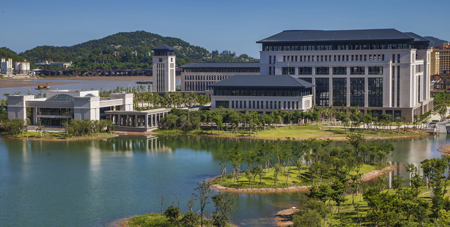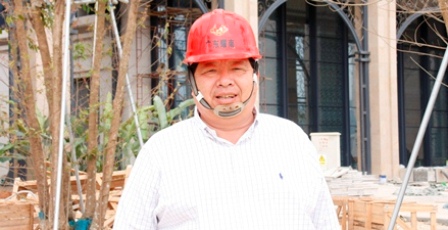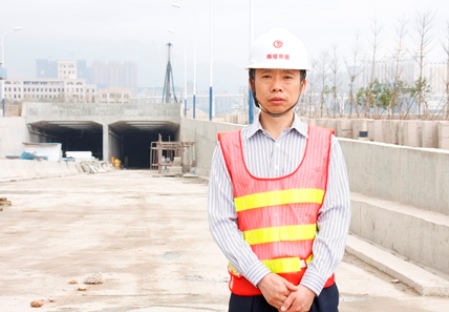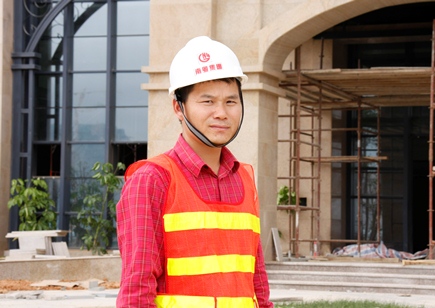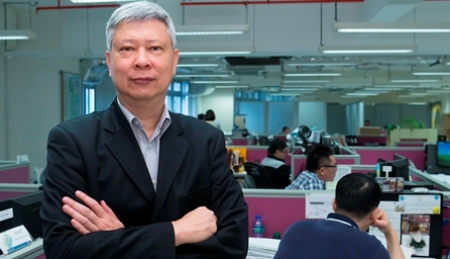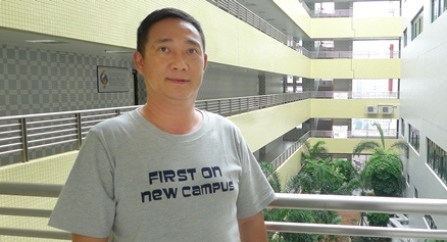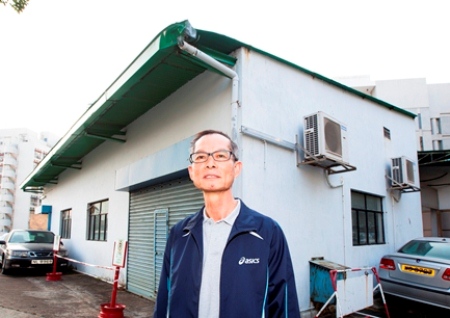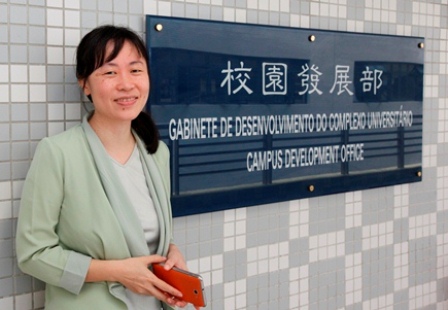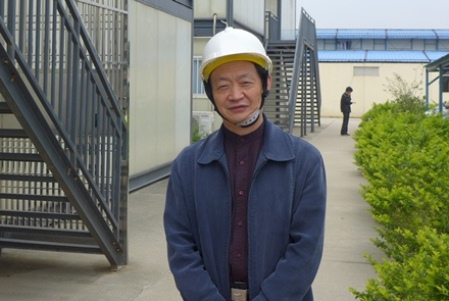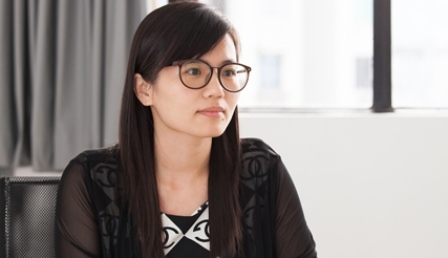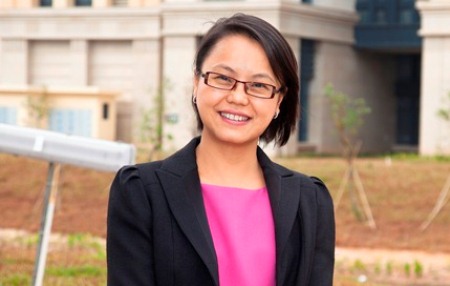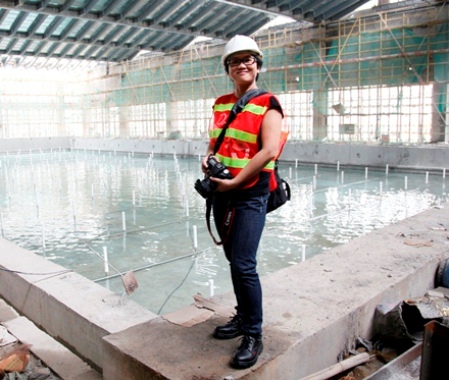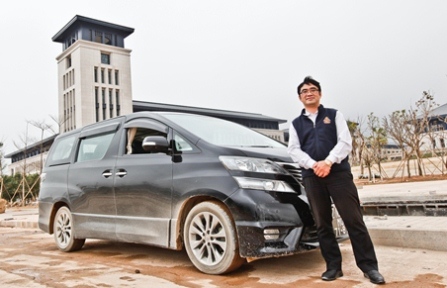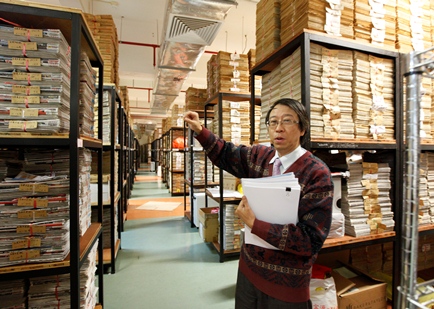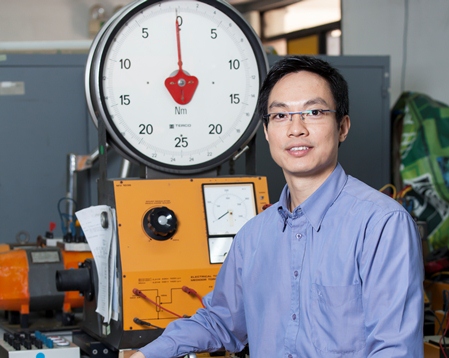It was the best of times, it was the worst of times. The University of Macau’s (UM) new campus, a cross-border collaborative project that involved the two cities of Macao and Zhuhai, is finally completed. For both UM and Guangdong Nam Yue Group Co. Ltd., the building contractor of the campus, the three years of construction has been one of the most challenging times but also—in retrospect—one of the most satisfying experiences. When we set foot on the new campus for the first time after its completion but before its handover to Macao, we were impressed by its spaciousness and beauty. By that time all the construction workers had cleared out of the site. The racket was replaced by a dreamy quietness. The sky was a seamless expanse of blue broken only by the hip roofs. Where countless workers poured concrete along with their sweat, now stood simple yet elegant buildings. Those who had worked hard to turn what had once seemed an impossible dream into a reality were nowhere to be seen, but their stories shouldn’t be lost. In this issue of umagazine we interview three people from Nam Yue Group and 12 staff members from UM to learn their stories of the campus construction project.
Ma Yinxian
From: Guangdong Nam Yue Group Co. Ltd. (building contractor)
New campus-related responsibilities: Managing construction
workers
Ma Yinxian started working on the construction site in May 2011, after the new campus project entered the phase of building construction. When he saw the construction site for the first time, he said to himself: “Wow, I didn’t know it was this big! When are we going to finish all the work?”
Constructing more than 60 buildings on the campus simultaneously required meticulous plans. “I’ve participated in the construction of many schools in mainland China, but I’m afraid I’d be hard-pressed to find another project quite like this. It was such a large-scale project, which needed to be completed in one fell swoop,” says Ma. “And that’s why we had to make a lot of preparations beforehand; otherwise things would have been in a complete chaos. My job on the construction site was to make sure the workers were executing the plans as per the requirements.”
Ma has lost count of the number of problems he had to solve on the construction site, because new problems arose on a daily basis. “The most difficult time was during the beginning of the construction,” explains Ma. “Because of the complicated geological conditions, we needed to improve the soft soil using vacuum preloading, which put higher demands on the workers. Moreover, the construction standards in mainland China are different from those in Macao, and we needed to follow whichever are higher. Also, the procedures for approving materials were very strict. These all added to the difficulty.”
At the height of the construction, more than 10,000 workers worked around the clock. Ma was in charge of approximately 2,000 of them. “The workers were very cooperative. They didn’t need to be told what to do. Everyone wanted to get the job done as soon as possible, because of the pressure of the tight construction schedule,” says Ma. “And now seeing all these buildings, I feel so happy and proud!”
“I’m honoured and proud to be a part of this project.”
Zheng Xiaoming
From: Guangdong Nam Yue Group Co. Ltd. (building contractor)
New campus-related responsibilities: Technical coordination and
management for tunnel construction
As a cross-border collaborative project between Guangdong and Macao, the new campus presented a great challenge in coordination because of the need to follow two sets of standards and laws. To make sure that targets for construction schedule, quality, safety and costs were met, Guangdong Nam Yue Group Co. Ltd., the building contractor of the campus, established a project management team comprised of more than 400 people with different specialties to be responsible for project control, technical coordination, and onsite supervision.
Zheng Xiaoming, who started working on the construction site in 2009, was one of the core members of this team. Zheng was mainly responsible for technical coordination and management for tunnel construction. He organised engineering and geological surveys, schematic design, working drawings, and expert evaluation. Zheng explains that numerous new technologies have been adopted in the construction of the underwater tunnel to make sure that the tunnel is strong enough to withstand magnitude-7 earthquakes and floods having a 100-year recurrence interval. The foundation pit works alone generated 620,000 cubic metres of refuse, indicating the enormous workload. “Both the governments of Guangdong and Macao SAR have invested a lot of time and energy in this project,” says Zheng. “A lot of workers were involved in the construction. They worked and lived on the construction site. Everyone went all out, from the management team to ordinary workers. Being there—watching everyone working together with nothing held back, you couldn’t help but want to give your best too. The excellent rapport allowed us to work efficiently. And I’ve learned a lot from the high standards of Macao.”
Zheng spent the best part of the past three years on the construction site. Even on the rare occasions when he did manage to take a few days’ leave to go back home in Shenzhen, he didn’t stop working—he continued to confer with his colleagues about work via text message and email. “Working on the new campus project has left me with a lot of unforgettable memories,” says Zheng. “Yes we had to finish a lot of work on a very tight schedule, but I’ll never forget how everyone worked together, sometimes around the clock, to meet the deadlines. I’m so happy that the campus and the tunnel have been completed. It would not have been possible without the joint efforts of the entire team. I feel very honoured and proud to be a part of this influential project.”
“We’ve made a great effort to deliver a satisfactory campus.”
Luo Junrong
From: Guangdong Nam Yue Group Co. Ltd. (building contractor)
New campus-related responsibilities: Onsite construction management and coordination for the University Hall, the Administration Building, the sports facilities, the Faculty of Science and Technology, and the Faculty of Health Sciences.
Luo Junrong is an engineer at Guangdong Nam Yue Group Co. Ltd. He started working on the construction site in May 2010. Back then the place was overgrown with weeds. Mud and sand were everywhere. He remembers thinking on his first day on the site, “A major construction project like this would be a wonderful opportunity to prove my ability.”
One of the greatest challenges Luo faced was the car park connecting the University Hall and the Administration Building. “That place used to be a flood relief channel, so the geological conditions were very complicated,” explains Luo. “There were deep mud and a lot of rocks used as filling material. We needed to excavate the site to build an underground parking lot of about 30,000 square metres, which was very challenging. Then there was the University Hall. We needed to dig down to nine metres deep in order to build a standard drop stage, which was also a very demanding task. The high construction standards required by Macao and the tight construction schedule further added to the difficulty. We had to spend more time and use more equipment than usual to get the job done.”
Luo says the challenge is reflected in many details. For instance, stone materials were used for more than half of the over 60 buildings on the campus, amounting to a total surface area of 220,000 square metres. And for some of the buildings, such as the University Hall, the Administration Building, the Wu Yee Sun Library, the University Gallery, and the Central Teaching Building, stone materials were used as cladding for the entire facades. “The stone materials were mined from Fujian. Mr. He Jingtang, chief designer of the campus, appraised the stones for their quality and colours himself. It took more than 2,000 truckloads of stone materials and over three months to complete the entire procedure.”
Over the past three years Luo has gained a lot of experience in personnel training and project management from his fellow workers from Macao, but the gain has come at a price—less time for his family. “A while ago, my five-year-old daughter had a surgery, I didn’t even have time to go back to check on her,” says Luo. “I felt awful that I wasn’t there for my baby girl, but work was so busy it was simply impossible to leave. And I wasn’t the only one—a lot of my colleagues have sacrificed a lot in order to deliver a satisfactory campus to Macao.”
Luo says that over the past three years he and his colleagues have worked at full throttle, especially towards the end of the construction. “I think we won’t be able to truly relax until after the new campus is completely handed over to Macao.”
“The new campus presents a new challenge.”
Gordon Song
From: Campus Development Office, UM
New campus-related
responsibilities: Coordinating new campus planning, carrying out post-handover
construction works, and monitoring construction progress.
Gordon Song is the director of the Campus Development Office at the University of Macau (UM). Before joining the University of East Asia, the forerunner of UM, in 1985, he was the site manager of a construction company which was responsible for constructing several buildings on UM’s old campus, and Gordon was in charge of the Tai Fung Building, the K. C. Wong Building, the Cultural Centre, and the Ho Yin Convention Centre. Over the years, his office has experienced a lot of changes—its functions have changed continuously to keep pace with the development of the university, and the number of staff members, which was only six or seven in the beginning, has increased to more than 20.
In 2009, the new campus proposal was officially approved, which meant what had once seemed like an impossible dream finally became an attainable reality. But that was also when Gordon and his coworkers’ lives became increasingly busy. “That was when we began to think, ‘what kind of a campus do we want to build?’” recalls Gordon. He and his colleagues, led by the university’s top management, visited many universities around the world to learn from their experience in campus design and planning. “We needed to prepare a detailed campus planning document with extremely limited reference materials to draw on,” says Gordon. “We needed to complete the design specifications for several dozen buildings within just a month so that the designer and the contractor could carry out their work. We needed to determine how many buildings we would need, the functions of each building, the facilities needed, the standard sizes of the offices, the rough number and distribution of the classrooms, the size of the residential area for the students, the student/teacher ratios, and the like. On top of these tasks, we needed to collect comments and suggestions from the various offices and departments on a lot of issues, such as what centres and laboratories they would require. Things like how the campus was going to operate in the future also needed to be considered. What made matters worse was the shortage of staff. We were literally in a race against time, and everyone worked extremely hard.”
One of the greatest challenges of such a large-scale project was the tight construction schedule. “During the design phase, not only did we need to look at tons of drawings, but we needed to give our feedback in writing within a very short time frame. We had to complete at least two to three such written reports every week,” recalls Gordon. “Also we needed to meet with the contractor and the designer to go through these written reports item by item. Each meeting took at least half a day.” From late 2009 to 2011, Gordon and his teammates pored over more than 20,000 drawings. During that period, almost all his colleagues had to work a lot of overtime, so much so that they later became used to working in the office until past eleven o’clock at night. Luckily for Gordon, he has a diverse team with complementary strengths and expertise. Some of his teammates are Macao natives, with the rest coming from around the world. One of them comes from mainland China and was a member of the Construction Command Centre for the Higher Education Mega Center in Guangzhou. Another was a landscape engineer and architect in Taiwan before he joined UM. One is a Malaysian quantity surveyor. Four others are from Hong Kong and have rich experience in large-scale construction and electromechanical works as well as project management.
During the time after the new campus entered the phase of quality inspection but before it came under the jurisdiction of Macao SAR, Gordon needed to commute between the two campuses on a regular basis. “During that time I went to the new campus at least once every week,” says Gordon. “Our workload increased considerably around March and April when the buildings on the new campus began to receive quality inspection. At the same time we needed to handle a large amount of follow-up work, such as preparing invitations to tender and evaluating the bid documents we received.” After the new campus came under the jurisdiction of Macao SAR, the Campus Development Office became the first office to move to the new campus entirely.
Looking back on the past three years, Gordon admits he has had his share of setbacks and frustrations. “We worked extremely hard preparing design specifications and going through all those drawings. Sometimes we came up with design ideas which we thought were in the interests of the university but which were banned for various reasons, naturally I got a little upset and frustrated,” concedes Gordon. “But later I came to realise that difference in opinion is unavoidable for a large project like this, because it involved a lot of parties, and it really wasn’t necessary to get upset about it. And what touched me the most was the fact that everyone was working hard together towards the same goal, and everyone was giving their best, from the rector to the rank and file, and colleagues became closer in the process.”
Gordon is very excited and happy to work on the new campus, although he says he sometimes misses the old campus. “It was very impressive what the university has achieved on such a small campus, with all its limitations,” says Gordon. “Of course, the new campus is much bigger and more advanced, but how do we make good use of it and how do we develop and manage it in the future? That’s a new challenge.”
“Everyone is giving their best.”
Dick Lai
From: Campus Management Office, UM
New campus-related responsibilities: Procuring furniture for the new campus, stocktaking of furniture on the current campus, as well as transport, security, cleaning and asset management.
Dick Lai, head of the Security and Transport Section of the Campus Management Office, recalls that one day in April 2010, Vice Rector Alex Lai called him to his office and asked if he was interested in taking charge of an important job. That’s how Dick was transferred to the Rector’s Office to take on a new responsibility—procuring more than 100,000 pieces of furniture and small equipment for the new campus as well as making an inventory of the approximately 50,000 pieces of furniture on the current campus.
Dick Lai was formerly responsible for the university’s security, cleaning and asset management. As early as 2009, his department was already assigned many new campus-related tasks. “For example, we needed to provide a large amount of data within a short period of time to facilitate the design process,” recalls Dick. “Since we have different units, we needed to decide how much space each unit would need to work and put their stuff. Also there are more than 60 buildings on the new campus, so we needed to decide how we were going to divide the security presence into different sections and how big each section should be, as well as what equipment we would need. Being suddenly assigned to such a large-scale project with such a tight schedule and with no prior experience to draw on was at once challenging and exciting for me and my colleagues.”
Procuring furniture for the new campus sounds simple, but as Dick and his colleagues will tell you, is actually extremely complex and involves the consideration of many details. “For example, questions we had to consider included, How many classrooms and offices will we have? How many people will be in each office? What kind of furniture will we need? How many rooms will we have in the residential colleges and the Staff Quarter? How many single rooms and double rooms will we have? How many people will actually live in those rooms? How many labs, pantries and bathrooms will we have? How much furniture do we need for all these rooms? We needed to go through a sea of drawings to arrive at some accurate numbers before we could work out a budget,” explains Dick. “Because if we couldn’t get those numbers as accurate and early as possible, our actual cost would be substantially over budget, which would be very difficult to revise with the tight schedule.” Dick and his colleagues faced the same challenge when trying to decide on a security system for the new campus. “We needed to decide what kind of security system we wanted to use,” says Dick. “Should we use the access control system and the CCTV system (closed circuit television system) to save manpower or should we put security guards in front of every building?”
Over the past three years Dick and his colleagues visited universities in Hong Kong, Taiwan, Singapore and other places, hoping to combine other universities’ experience with UM’s unique situation. In the end, Dick and his teammates proposed dividing the campus into several sections and positioning the security monitoring unit in one section for more convenient and effective management. “The new campus has various advanced systems, such as the BMS (building management system), the fire protection system, the access control system, the CCTV system, the smart lighting system, and the lift intercom system, which helps us to save manpower. But the locations of the cameras and the electric locks for the access control system need to be carefully planned. So we studied every floor of every building, and we looked at those drawings over and over again until we knew every detail like the back of our hands, which was very time-consuming.”
Because the new campus is now being managed by the contractor Nam Yue Group as a construction site, all vehicles need a permit to enter and exit the underwater tunnel, which is the only legal way to access the new campus. So Dick and his colleagues need to coordinate with Nam Yue Group to obtain permits. So far they have obtained permits for nearly 200 vehicles for UM staff and outside personnel. They also must monitor these vehicles to make sure that they comply with the relevant new campus parking rules as agreed upon with Nam Yue Group. Dick’s daily routine now involves commuting between the current campus and the new campus, as well as handling security, transport, and the delivery and assembly of furniture. Also, because over 1,000 students have already moved onto the new campus, Dick and his colleagues must coordinate with the Transport Bureau of Macao SAR about the bus routes and other related matters. Looking back on the past three years, Dick says, “The greatest challenge was the lack of definite timelines. Take furniture for example. The manufacturing, transportation, and assembly of the over 100,000 pieces of furniture for the new campus all required time. And the lack of definite timelines added to the difficulty. For example, the furniture delivery date was changed three times, and it took us a lot of time to coordinate with the supplier. But luckily, I have a team of great partners who never complained about the hard work.”
After the first batch of furniture was moved onto the new campus in August, Dick immediately carried out the first air quality test in collaboration with the Office of Health, Safety and Environmental Affairs. Representatives from the Students’ Union were also invited to participate in the testing. “Our test results showed that the content of formaldehyde was within the safe range, which proved that the manufacturer did use environmentally friendly materials as per the requirements of the tender documents,” Dick explains. Dick says that despite the heavy workload, everyone is giving their best, hoping to bring the relocation to a perfect ending.
“The new campus is what has motivated us.”
Chan Seng Iong
From: Campus Management Office, UM
New campus-related
responsibilities: Building repair and maintenance
Chan Seng Iong, affectionately known as Brother Iong among his colleagues, joined the University of East Asia (UEA), the forerunner of the University of Macau (UM), as a site engineer, in 1979. He was one of the first engineers at UM. At the time he was employed by the Ricci Island West Ltd., the company that founded UEA. Over the past three decades, he has witnessed the growth of the university every step of the way. When he learned in 2009 that the central government had granted a piece of land to UM for the construction of a new campus which would be 20 times larger than the existing one, he couldn’t help but gasp in wonder. “I remember thinking, with such a huge campus, the university’s potential would be limitless,” says Chan.
“When the university was first founded, it was practically a deserted wilderness,” recalls Chan. “We had to ferry water uphill with water wagons and generate power using a generator. There were only a dozen students and three buildings, the Tai Fung Building and two dormitory buildings. In fact when the first semester began, we found the existing classrooms were far from enough, so we had to convert cargo containers into temporary classrooms.” Indeed, the problems arising from an acute shortage of campus space and facilities are not only among Chan’s deepest memories, but they were also the biggest headache he had to grapple with before the new campus was available. “We had to rack our brains trying to convert the existing facilities to serve different purposes in order to meet the university’s changing needs,” says Chan. “For example, the Ho Yin Convention Centre, which was originally designed as a restaurant, was subsequently converted into a library, an office building, a classroom building, and a lab building.”
Perhaps the need for a bigger campus was never more acutely felt than when the number of students quickly surged from 2,000 to more than 3,000 after the university was acquired by the local government. “Imagine the sudden increase in the demand for faculty offices, classrooms and teaching facilities,” says Chan. “The university was crying out for more space, which we didn’t have, so we had to renovate, reconstruct, and otherwise improvise, to meet the demand.” Opposite the Pearl Jubilee Building stand a row of what UM members now refer to as the “tin-roofed houses”, which were among the temporary facilities built during that period. The original idea was that these buildings, which were intended as temporary laboratories, should last the university approximately three years before a new lab building was available.
It’s been 20 years, and these tin-roofed houses are still in use, a constant reminder of how the lack of a decent campus has severely hindered the university’s development. And having experienced firsthand the painful constraints of a tiny campus, Chan was especially excited when he learned the good news in 2009 that the central government had approved the construction of a new campus on Hengqin Island, a decision many believe has opened a new chapter in the university’s history. “When I learned that the new campus was going to be 20 times larger, I had a hard time imagining it, and even harder to imagine was how much farther the university could go with such a large campus,” says Chan. But even in the midst of his excitement, Chan has always been aware of the enormous challenges the new campus would bring in terms of maintenance and management. “Over the past three years, everyone was busy making preparations,” says Chan. “For example, we needed to calculate the quantity of new equipment we would need to procure. We also needed to think about how we were going to manage and maintain those facilities as well as how we were going to assign each task to different person. We want to be fully prepared so we wouldn’t be thrown into a state of chaos when the actual relocation takes place.”
Over the past three years, Chan and his colleagues have worked extremely hard, sometimes sacrificing weekends and holidays in order to get the job done. “The new campus is what has motivated us,” says Chan. “It has given us a lot more work for sure, but we don’t mind because it has also given us an exciting goal to pursue.” Chan says that being able to witness the different stages of the university’s development has given him a great sense of satisfaction, and he believes that with a new campus, the university’s future will be even brighter.
“It’s like a once-in-a-thousand-year opportunity.”
Li Chuanyi
From: Campus Development Office, UM
New campus-related
responsibilities: Design and drawing review and approval for the public works of the new
campus, including municipal roads, water supply and drainage systems, strong
current and weak current systems, waste disposal systems, and underground
piping systems
Before joining UM in 2009, Li Chuanyi had participated in numerous large-scale infrastructure projects both at home and abroad, with more than 30 years of experience in project planning and construction management. He is currently the functional head of project management in the Construction Planning and Implementation Section, Campus Development Office. During the early phase of the new campus project, he was mainly involved in the public works, responsible for designing water, electricity and gas piping systems as well as reviewing and approving the relevant drawings. As the project progressed, he was mainly responsible for attending site meetings and monitoring the progress of the various sub-projects against the established schedules and standards. In addition to visiting the construction site at least four times a week, he also needed to liaise with the contractor and the management company on a frequent basis to relay UM’s expectations and requirements as the user.
Li says civil engineering is not rocket science, and the greatest challenge doesn’t lie in the technical aspect, but rather in the liaison and coordination with the various parties. The unique geographic location of the new campus has given rise to the need to follow two sets of laws and standards, as is often the case in many cross-border construction projects. Whenever a problem arose, a dozen meetings had to be held with the various parties concerned to find a solution. The need to follow the higher of the two sets of standards during the construction process was one of the factors that added to the difficulty. Another factor that caused an increase in construction time and workload was the necessary corrective feedback provided by UM as the user.
For the new campus project, design and construction went hand in hand, which considerably increased the workload for Li and his team. The process involved several stages (basic planning, draft drawings, formal drawings, working drawings, first decoration, and fine decoration) and hundreds of thousands of drawings. “During the planning and design phase, there were lots of drawings to review and approve,” says Li. “We worked long hours, sometimes pulling all-nighters and cancelling holidays.” Li says the design of the new campus was conducted in a systematic and well-thought-out manner. “It would be very difficult to find another campus in the world whose design and construction were completed in one fell swoop,” says Li. “Not only does the new campus have advanced facilities, but many of these facilities are environmentally friendly. For example, the campus has the water recycling system, lake water purification system, rainwater harvesting system, flood prevention system, natural gas system, and solar power water heating system. It’s the first time in Macao that environmentally-friendly systems have been used on such a large scale in a single project.”
Having been involved in university construction projects for over 30 years, Li has grown especially fond of such projects. “Being able to participate in the construction of the campus is like a once-in-a-thousand-year opportunity, and I feel really honoured,” says Li. “It has been wonderfully challenging, and it has enriched my professional experience.“I hope to take some rest to prepare for the journey ahead.”
Kinny Hoi
From: Rector’s Office, UM
New campus-related
responsibilities: Providing administrative support and coordinating the efforts of various
parties
Kinny works in the Rector’s Office. She was among the first few UM colleagues to learn about the new campus project. “I remember it was 29 January 2009,” says Kinny. “That night Vice Rector Alex Lai called to ask me to prepare a proposal about the new campus as soon as possible—said it was to be submitted to the government.” After getting off the phone, Kinny rushed back to the campus and worked on the proposal until deep into the night. As she leaned back in her chair and stretched after completing the work, she realised it was just the beginning of a long journey that would be at once challenging and exciting.
As the director-coordinator (administration and support for new campus project), Kinny was mainly responsible for providing administrative support and coordinating the efforts of various parties. “I was involved right from the beginning, from writing the first proposal to the government to preparing materials for meetings and sorting documents later on,” says Kinny. “Sometimes when I ran into the rector, he would joke and say nobody knew the new campus project better than me.” As the project progressed, Kinny’s work became increasingly busy. “At that time we needed to meet with the South China University of Technology School of Architecture, which was responsible for the new campus design, in the contractor’s office in Zhuhai on a regular basis,” says Kinny. “And I was mainly responsible for providing administrative support to facilitate the communication between the university’s top management and the design team. Later when the drawings were ready, I needed to prepare the relevant documents and forward them to the University Council, the Rector’s Office, and various other units concerned, and I also needed to arrange meetings for those concerned to discuss whether the design style met the university’s requirements and expectations, and after the meetings, I needed to liaise and coordinate with the Infrastructure Development Office of Macao SAR back and forth.”
Later when the project entered the construction and relocation phases, Kinny was appointed one of the main contact persons, responsible for assisting Vice Rector Alex Lai in coordinating the work of the various task forces. “Over the past year, I’ve been mainly assisting Rector Wei Zhao and Vice Rector Alex Lai in coordinating the efforts of various parties. My responsibilities mainly include arranging meetings, preparing reports based on the discussions at the meetings, and reporting the progress to the internal and external stakeholders on a regular basis.”
In addition to providing administrative support, Kinny has also served concurrently as the secretary on several new campus-related committees, which has not been easy, especially in the beginning. “It was hard because for one thing, I was new to the whole new campus business, and for another, the workload was extremely heavy. I needed to coordinate the efforts of various parties, to arrange everything around the schedules of the top management, because they too were very busy, and also to see to it that the deadlines were met. For a time, it became a norm for me to work in the office until two or three in the morning,” recalls Kinny. She even managed to squeeze in a course in purchasing management. The heavy workload not only left her with almost no time for family and friends, but also gradually took a toll on her health. One day she sat down at her desk as usual, ready to begin the day’s work, only to find that her hands refused to cooperate. Even lifting them required enormous effort. She went to one doctor after another, and both practitioners of western medicine and Chinese medicine made the same prescription—more rest. Luckily she gradually recovered, and her efforts paid off—work became easier with experience. “It’s been four years now, and I’ve gained a lot of experience in the process,” says Kinny. “Now in preparation for the many new campus-related meetings, I just know what kind of materials to prepare, what items will be on the agenda, and whether there is anything I need to remind the top management to pay special attention to.”
Having experienced firsthand the inconveniences of a cramped campus over the years, first as a student in the Faculty of Education, and later as a staff member at UM since 2004, Kinny felt especially excited when she learned about the possibility of a new campus. And the four years that followed has been full of landmark moments and unforgettable memories—from the groundbreaking ceremony held on 20 December 2009 to the recent handover of the new campus (on 20 July 2013) to the Macao SAR government.
“The new campus project is coming to an end, and if you ask me how I feel—well, a lot of things. For starters, I feel tired and want to take a good rest,” says Kinny with a laugh. “Of course I feel very honoured to be a part of this huge project. Everyone has been working so hard, and everyone is giving their best. It’s very touching how people supported, learned from, and collaborated with one another under the enormous work pressure in order to accomplish a common goal. I hope that after we settle down on the new campus, I could take some rest, to review the progress I’ve made and the areas for improvement, and then pack away useful experience for the journey ahead. Actually this interview gives me a chance to do just that.”
“One word sums it up: busy.”
Katrina Cheong
From: Communications Office, UM
New campus-related
responsibilities: Promotional and public relations work for the new campus project
For Katrina Cheong, director of the Communications Office (CO), what it feels like to be involved in the new campus project can be summed up in one word—“busy”. Throughout the new campus project, from planning to construction to inauguration, CO was mainly responsible for internal and external communication, public relations, and promotion. “With the start of the project, my office began organising new campus visits, carrying out PR work, and holding consultation sessions,” says Katrina. “At first there were a lot of voices of doubt and concern about various issues. For example, some asked, ‘Will we have to go through immigration clearance?’, or ‘Will we be able to access the internet in the same way as we do in Macao?’ In response to these questions, we carried out a series of promotional activities, and now our students and colleagues know much better about the new campus, and we are hearing more positive comments. A lot of people have expressed their eagerness to move to the new campus.”
The idea of constructing a new campus on Hengqin Island has engaged the local populace ever since it was publicised. The period between early 2009, when the university learned the good news that the new campus would be approved, and 27 June 2009, when the National People’s Congress Standing Committee officially approved the construction of the new campus, presented a tricky situation for Katrina. “We were not able to officially disclose the news, so we had to convey the message to the public through appropriate channels and in appropriate ways, which was enormously challenging,” says Katrina. “Later we organised over 20 consultation sessions to explain the necessity of building a new campus on Hengqin Island. During the design phase, UM as the user wished to provide some input, and so we again organised a lot of consultation sessions.”
In 2010, when the construction of the new campus officially began, CO’s focus shifted to the local community as well as overseas markets. “The importance of the new campus is not just confined to UM and Macao,” says Katrina. “We also hope to arouse overseas interest because it would go a long way towards promoting our university internationally.” In the following two years, as the construction progressed at full throttle, CO changed its focus yet again—this time to internal communication. “We regularly updated our colleagues and students on the latest progress of the new campus to make sure to involve everyone in the process. We didn’t want our colleagues and students to just sit back and think that the new campus was something that only concerned the top management,” says Katrina. During that period, CO frequently organised new campus visits for UM staff, students, and visitors, continued to carry out a series of design and promotional activities, and coordinated interviews by local and non-local media. Over the past three years, Katrina worked a jam-packed schedule, and her colleagues also worked a lot of overtime. But Katrina says watching a former plantain plantation transformed into a beautiful campus has made all the hard work worthwhile. “My two sons were born during that period. You know, those of us involved in the new campus project sometimes joked that we were like the midwives trying to bringing a new baby into this world. So it felt kind of special to give birth to two babies while the new campus was being built,” says Katrina with a smile.
UM with a new campus is faced with a future full of new possibilities. What hopes and expectations does Katrina have for the new campus? “The new campus has a much larger space and advanced facilities to support the university’s efforts to carry out its educational philosophy and policies,” says Katrina. “I think this will give us greater room for our promotional work. The university has also established very clear goals and strategies for achieving those goals. This will make it easier for us to carry out our work in line with them. Another thing that’s noteworthy is that little by little our work has been recognised by the local community, and building on this foundation, I believe our university will gain greater recognition in the future, which is very important.”
“If I had to use one word to describe the new campus, it would be big.”
Ella Cheong
From: Communications Office, UM
New campus-related
responsibilities: Making photographs and videos about the construction progress
Ella works in the Communications Office. Her earliest memory of UM’s new campus dates back to 27 June 2009, when the National People’s Congress Standing Committee officially approved the construction of the campus on Hengqin Island. Shortly after that, Ella went on a site visit to Hengqin Island with some UM colleagues. “I remember it was a scorching summer day,” recalls Ella. “Back then the new campus site was still a plantain plantation with no clear boundaries. I remember the area where I was standing was strewn with oyster shells. Actually I wasn’t clear about the exact location of the future new campus. I took a picture, which later turned out to be useless because I was at the wrong location. So then we drove to another spot with the new campus site in the background.”
After learning about the possibility of building a new campus on Hengqin Island, the Communications Office began contemplating the idea of documenting the construction progress with photographs and videos. “During the construction phase, the appearance of the new campus changes literally on a daily basis,” says Ella. “And our wish was to capture those otherwise fleeting moments on camera as they happen.” After the new campus project was officially approved, Ella and her superior Katrina immediately put the plan into action. Along with some student helpers, they searched high and low, even stopping casual hikers in Coloane to ask for advice, just in order to find a perfect photography location. “We looked everywhere, the rooftops of the observatory in Coloane, The Venetian, the Grand Waldo Hotel, the A-Ma Temple, the wastewater treatment plant in Coloane, even the Lotus Bridge,” says Ella.
In the end they selected three spots, the training ground of the Academy of Public Security Forces, the A-Ma Temple, and the wastewater treatment plant in Coloane. “It was very hard,” recalls Ella. “We went to many different spots. We literally covered every inch of the hill, just to find the perfect spot to set up the cameras. There was a lot of coordination involved in the process too, liaising with the three places, correspondence back and forth, and so on. But we were very happy that our work paid off in the end.”
In the beginning, the new campus didn’t change much from day to day because the early phase of the construction mainly involved land levelling. So Ella and a student helper made photographs and videos in Coloane and Taipa once a week and inside the construction site once every month. Only later did they increase the frequency of photography. “I can’t thank the Academy of Public Security Forces enough for their support,” says Ella. “Not only did they allow us to set up the camera box on the rooftop of one of the buildings, but they also helped us press the shutter at fixed times on Mondays and Wednesdays because the camera needs to be operated manually. So we left the key with the drill masters, and went back on our weekly photography day to collect the memory card.”
For Ella, those days were not just hard; at times it was even heart-stopping. “The toughest part was climbing the seven-storey building in the academy,” recalls Ella. “I’m afraid of heights, and there were no railings around on the rooftop. The first time I climbed to the top, I was so scared my legs were shaking and I could barely look down, for fear of falling off to the ground. Another time I went to the A-Ma Temple to take pictures. The driver was driving very fast, and the ride up the hill was full of sharp bends, I got so carsick that when I got out of the car, I was pale as a ghost. I could hardly stand. Only after resting for quite a while did I manage to lift the heavy camera and climb the long stairs to the top of the temple. I will never forget those days.” Due to the lack of manpower, it was another year of enduring heart-stopping heights and getting carsick before Ella’s responsibilities were taken over by her photographer colleagues.
If Ella had to use just one word to describe her feelings about the new campus, what would that word be? “Big!” says Ella. “It’s so big that sometimes when I want to take pictures of it, I don’t know where to start. Walking the length or the breadth of it is also no picnic. So every time I take pictures of the new campus, I focus on the new changes.” In spite of the many difficulties, watching a former plantain plantation gradually transformed into the beautiful new campus and capturing those precious moments on camera and in words along the way have filled Ella with excitement and joy. “My work has allowed me to interview many people involved in the [new campus] project. I know how hard they have worked and how much they have sacrificed for the new campus,” says Ella. “Unlike the buildings, what they did is not there for everyone to see, but their work has been every bit as important as that of the designer and the construction workers. And being personally involved in the process has given me a whole new understanding and appreciation of their work. They are the unsung heroes.”
"I feel very proud."
Cheang Peng Guong
From: C-Vision Culture Development Co. Ltd. (transport contractor)
New campus-related
responsibilities: Driving UM’s top management and staff to the new campus for meetings
Over the past two years, Cheang has had numerous unforgettable experiences while driving UM’s top management and staff to the new campus for meetings. Once he drove Gordon Song, director of the Campus Development Office, and his colleagues to Hengqin, where they had a meeting until almost midnight. Knowing that it was already past the office hours of the Hengqin Border, which closes at eight, he decided to try Gongbei instead. They arrived with just a few minutes to spare, narrowly escaping having to stay a night in Zhuhai. Another time, his car got stuck in the mud on the new campus, and it took two hours and a crane called by the contractor to lift it out of the mud. For a split second after he saw the rescued new car encased in mud, he couldn’t help but imagine the expression of the person he was going to pick up when he saw this mess, but enough time had been wasted, so he had to press on.
Cheang says that he has met a lot of people working at UM, and he has always enjoyed talking to them. “You know what? All the faculty deans—their first visits to the new campus were in my car,” says Cheang. “I’ve driven many people to the new campus, and the first thing they usually said after they saw the new campus for the first time was, Wow, it’s very big and impressive. I feel very proud to be a part of the new campus project. I will certainly take my wife and children to the new campus some day to have a look.”
“There has never been any larger-scale library relocation in Macao’s history!”
Raymond Wong
From: University Library, UM
New campus-related
responsibilities: Coordinating the procurement of library supplies and relocation of the
books, as well as coordinating the planning and layout of the library on the
new campus.
“There has never been any larger-scale library relocation in Macao’s history,” says Raymond, UM’s assistant librarian. Over the past three years, Raymond and his colleagues spent a lot of time and energy preparing for the relocation of the library, which will take place in two stages.
The first stage will be devoted to moving the most urgently-needed books, back numbers, as well as books from closed stacks and rarely used stacks. Ancient books and old newspapers that are not urgently needed will be moved during the second stage. Raymond says that he and his colleagues foresee a lot of challenges in the relocation process. “The library currently houses an astounding number of collections, including about 500,000 copies of catalogued books, 150,000 copies of non-catalogued books, as well as innumerable journals and old newspapers,” explains Raymond. “We will need to move about 40,000 boxes of items, and unlike the current library, in which only one floor is used as the stacks area, the library on the new campus will have four floors dedicated to that purpose, and this presents a big challenge for us—how do we re-arrange the books from one floor into the four floors? Before packing we need to accurately calculate the average capacity of each floor while also making allowance, as accurately as possible, for future expansion of the stacks areas. The fact that the current book stacks have seven levels while those on the new campus will only have six further adds to the difficulty in estimating.”
The shortage of workers was what worried Raymond the most in the beginning. Later the university assured Raymond and his colleagues that a moving company would be hired to help with the move, lifting a huge load off Raymond’s mind. Raymond says the process of planning the move was an experience he will never forget. “At first we had no way of knowing the exact layout of the new library. All we could do was look at the design drawings and try to imagine how we were going to divide the not-yet-built library into different sections and how we were going to put the book stacks in the different sections,” says Raymond. “So we spent a lot of time estimating the volume and capacity of the new library, but inevitably there was some gap between our estimates and the actual figures, which added to the difficulty.” The calculation was done by Raymond alone. “We have 160 different kinds of collections in our current library, and how we divide the new library into different sections so as to achieve the most efficient layout is kind of like playing chess, which requires you to think many steps ahead and allows no misjudgment. And I thought we stood a better chance of achieving that if the calculation was done by one person,” explains Raymond. Indeed, who was more suited to the job than Raymond, who has been working at the library for more than 20 years and is unsurpassed in his familiarity with the location of every object in the library?
How long the library would remain closed due to the relocation was not just a question on many people’s minds, but it was considered a test of the library’s ability to complete the relocation without causing undue inconvenience to the users. Luckily for Raymond and his colleagues, there is prior experience to draw on. “When the library moved from the Ho Yin Centre to its current location in 1999, there were about 140,000 books, and it took three months to prepare and two weeks to complete the relocation,” says Raymond. “Now we have three times more books, but with the experience from the previous relocation, we are confident that we can complete the relocation within three weeks.” The library will entrust the relocation of some odd volumes of special collection books to the students, as part of UM’s efforts to carry out education outside the classroom to help students acquire soft skills.
The library currently has approximately 130 rows of book stacks, with a total length of 10 kilometres, equivalent to the length of two Macao Friendship Bridges joined together. The number of book stacks will double after the library moves to the new campus. Some of the current book stacks will be converted into compact book stacks and others will stand by for future use. During the relocation period, students, faculty members, and administrative staff will still be able to access the online database. “The library’s e-database will only be closed on the last day of the library’s move so the server can be moved to the new campus, and the system will be re-opened on the new campus the next day,” says Raymond.
With a floor area of 32,000 square metres and a usable area of 18,000 square metres, the new library will have the capacity to house approximately 1 million copies of books, which should be able to accommodate the ever-growing collections, at least for the next three to five years. But even the largest library in the world cannot handle the ballooning collections indefinitely without the help of modern technologies. “I think in the future we will introduce more ebooks and compact shelving,” says Raymond. “In fact, I think in the future our new library will have the largest electronic shelving system in Macao, and we are also going to launch more services and continue to share our resources with the community.”
“I feel like every day is just whizzing by.”
Lam
From: Faculty of Health Sciences, UM
New campus-related
responsibilities: Coordinating the procurement of laboratory supplies, the relocation of
the current laboratories, as well as the planning of the layout of the
laboratories on the new campus.
Lam received his bachelor’s and master’s degrees from UM’s Department of Civil and Environmental Engineering. Having worked in the Faculty of Science and Technology (FST) since 1995, he is very familiar with the faculty and various laboratories. Now he has been transferred to work in the Faculty of Health Sciences, but he continues to be involved in the relocation of FST’s 58 laboratories. Lam and his colleagues began preparing for the relocation three years ago when they learned the university’s plan to move to the new campus. With the support of the dean and his superior as well as the assistance of a consulting firm, Lam and his colleagues devised a meticulous relocation plan.
Lam says that the greatest challenge is the lack of workers. “On average, every lab technician needs to take care of 2.6 labs,” says Lam. Another challenge lies in the relocation of precision instruments and heavy-duty equipment. “We have 58 labs and over 6,200 lab devices, which will require about 26 suppliers to dismantle, move, re-assemble and re-calibrate,” explains Lam. “50 items have special requirements for moving and procurement, which involves a lot of coordination. Some large, heavy instruments will need to be moved with cranes. Luckily, some of FST’s labs on the new campus are on the ground floor, which will save some trouble of lifting the heavy instruments upstairs.”
In addition to new campus-related responsibilities, Lam also needs to handle a large amount of administrative work, inspect some of the laboratories on a regular basis to ensure compliance with the relevant safety standards (because he concurrently serves as the lab safety officer), arrange leakage prevention drills, and provide pre-class safety trainings for new students. With such a busy schedule, Lam feels like every day whizzes by. “I wish there were 36 hours in a day,” Lam jokes.
“Incredibly busy yes, but at the same time I feel very honoured to be a part of this big relocation project. Our excitement about the new campus has been the greatest motivation. And I feel very lucky to be able to work with a bunch of very competent colleagues who not only support but also really understand one another. Sometimes we don’t even need to speak—a look, a nod, a frown, and we immediately know what the other is thinking. This kind of rapport has made our work very smooth and great fun. And I myself have learned a lot from the process.”
“We believe we can accomplish this task successfully.”
Stanley Seak
From: Information and Communication Technology Office, UM
New campus-related
responsibilities: Network design and planning, as well as planning and relocation of
telephone and wireless systems.
Stanley was mainly responsible for the infrastructure aspect of the campus network. He and his colleagues started the design and planning of the campus network after the new campus proposal was approved. They went through the design drawings of all the buildings to try to identify the best locations for the more than 560 network equipment rooms. They also needed to design the routes for optical fibre cables and campus network cables. “To make an optimum plan, we met with the designer regularly at the beginning to discuss how we wanted to design the campus network for each building as well as the network for managing campus facilities.” says Stanley.
After they decided on the best plan, Stanley and his colleagues set out to prepare specifications for network equipment and submitted the specifications to the contractor in order for it to purchase the most suitable products. Foreseeing the future challenges of managing and upgrading the wired and wireless networks on the new campus, on a scale Macao has rarely seen, Stanley and his colleagues visited many universities around the world, hoping to gain more experience.
But the preparatory work was not the hardest. The real challenge came after the new campus was handed over to UM. That was when they needed to implement step by step the plans they had made during the previous three years, including testing the networks, relocating internet service, installing the wireless network and telephone system, and so on. “Every member of our team has different skill sets which perfectly complement those of the other members,” says Stanley. “After more than three years of preparation, we believe we can accomplish this task successfully.”
Stanley says that the new campus will be a smart campus divided into 17 sections. Each section will have two independent networks, one for managing campus facilities such as access control systems and security systems, and the other for students, faculty members and administrative staff to use. The 17 sections will be connected via a 10Gb Ethernet. Advanced IP telephone system will also be adopted. As for the wireless network, Stanley discloses that the new campus will have approximately 3,800 wireless access points (WAP), the number of which could increase in the future should the need arise. These WAPs will be located in student dormitories, the Student Activity Centre, classrooms, and conference rooms, for the convenience of teachers and students.

